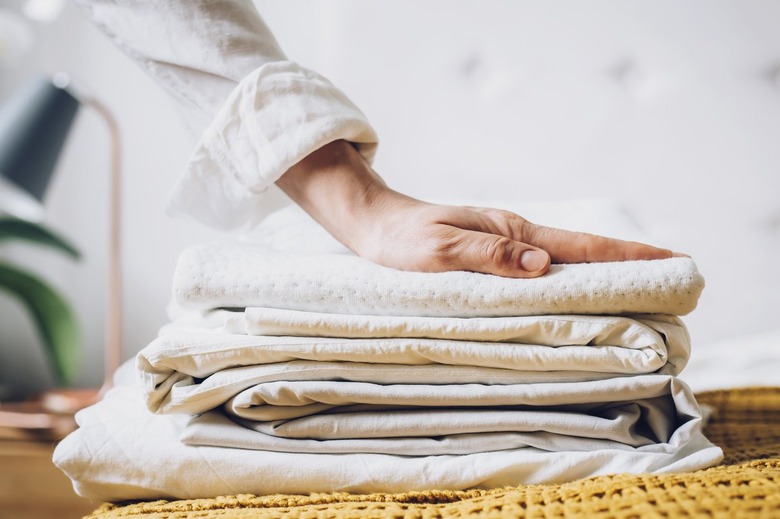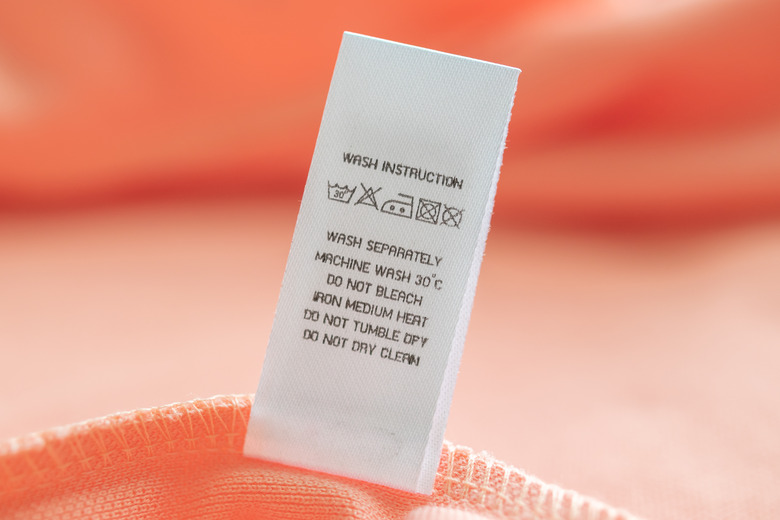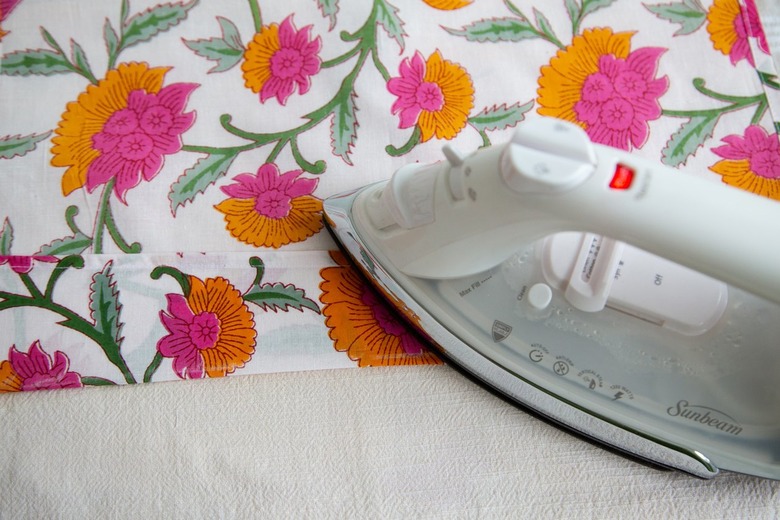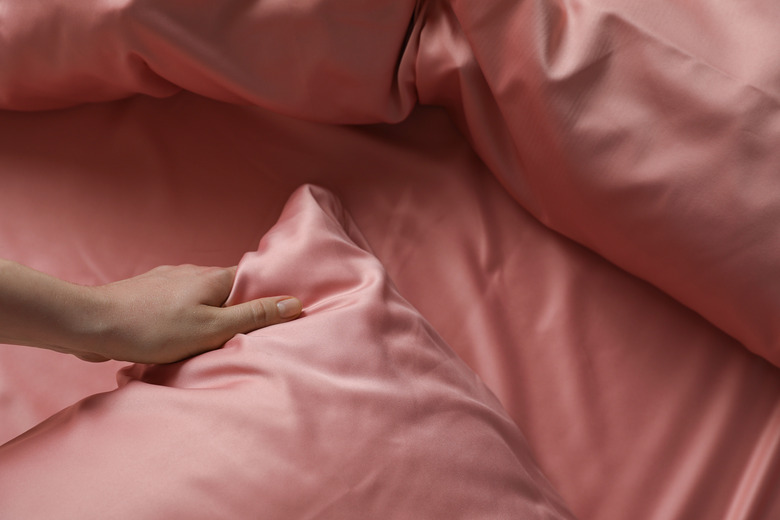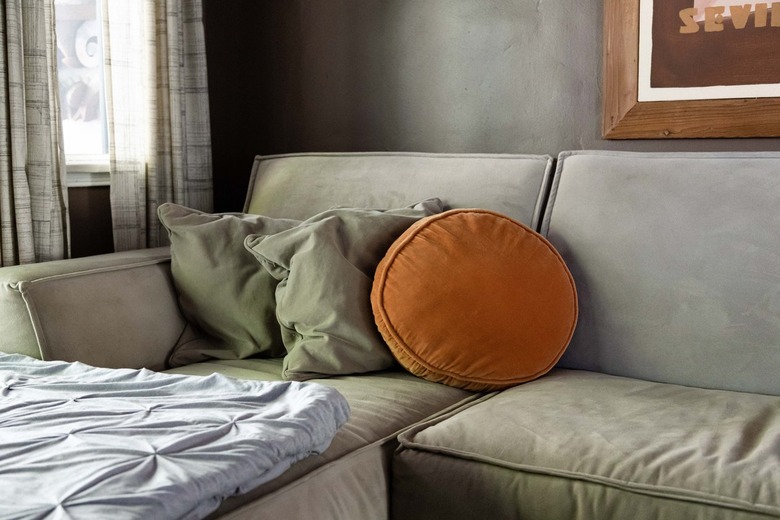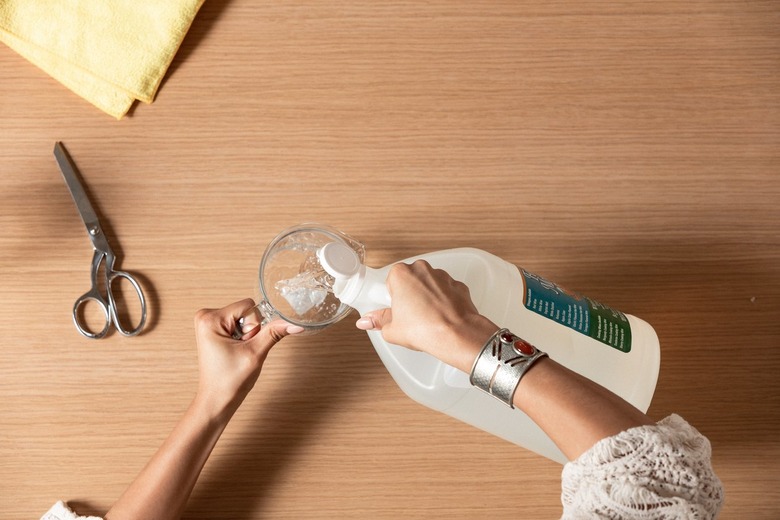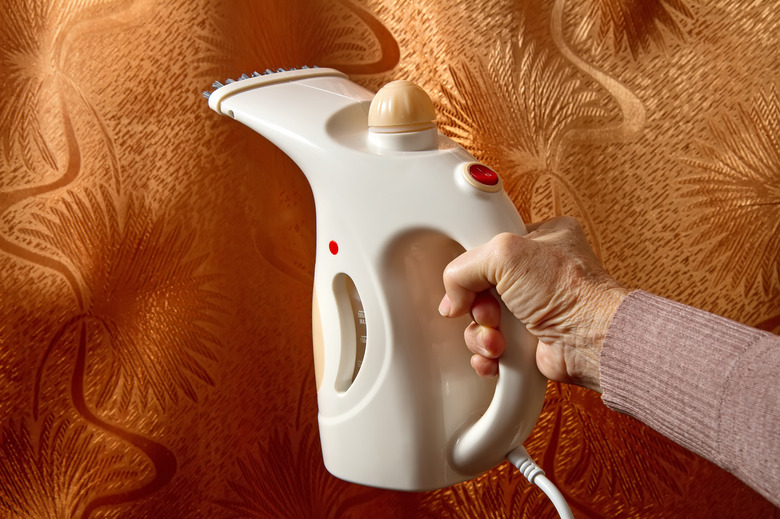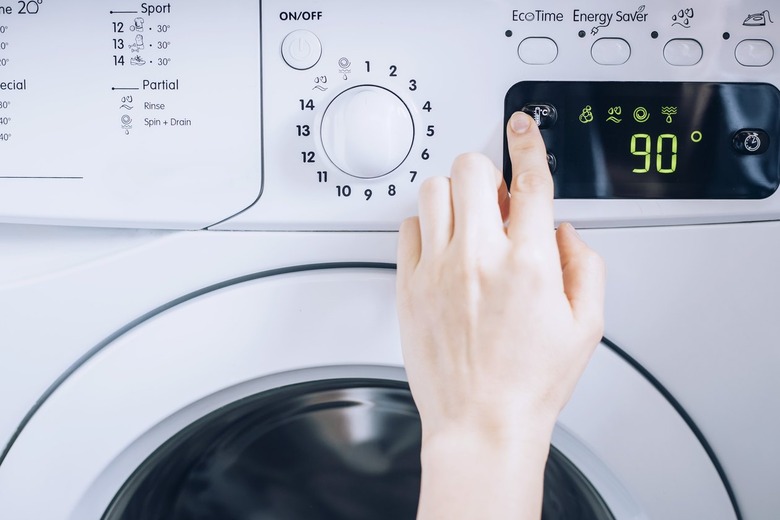How To Remove Water Stains From Fabric
We may receive a commission on purchases made from links.
Water itself typically doesn't stain fabrics; it's usually the minerals in the water that cause the stain. Hard water containing high levels of iron and manganese (typical with well water) or calcium and magnesium (more common in city water) can result in a whitish ring of mineral deposits left behind when the water evaporates. Water stains on fabric can also appear when the water attracts dirt or simply discolors the material. Another issue is rusty water, which leaves reddish or brownish stains and is often due to rusty water pipes, rust in the water heater, or high levels of iron in the water supply.
The best way to get rid of water stains on fabric — whether it's clothing, upholstery, or drapes — depends on how washable the stained item is. You can remove water stains in a washing machine or, for less washable items, using spot treatments with minimal amounts of water or even vinegar or steam. To remove most water stains from fabric, dampen the area with water and, if applicable, vinegar or laundry detergent, then wash the item or dry it with an iron or fan.
Tip
Prevent water stains from appearing in the first place by always using coasters when setting a drink down on fabric, cleaning the item regularly, and wiping away moisture as soon as you see it. This will also prevent mold and mildew from growing on your fabric.
Check the Label and Test the Fabric
Check the Label and Test the Fabric
Before you try any water stain removal method on fabric, check the manufacturer's care label for cleaning instructions, if there is one. Clothing and other textiles typically have a tag with specific washing instructions, while couches, chairs, and other furniture may have a cleaning code on the tag that indicates care requirements. Use the cleaning methods described in this article — which involve water or steam — only if the furniture fabric carries the code "WS" or "W," indicating it is suitable for cleaning with water. Fabric labeled with "S" or "X" should not be cleaned with water or steam and should be left to a professional.
To recap, here are the cleaning codes to look out for on furniture tags:
- WS: Can be cleaned with water.
- W: Can be cleaned with water.
- S: Dry clean only.
- X: Dry clean only.
If the label gives you the go-ahead, test your cleaning solution on an inconspicuous area of the fabric, such as an internal seam or any area that is typically hidden from view. This is to make sure the fabric is colorfast and won't be damaged by the cleaning.
To test clothing or other loose fabric pieces:
- Place a clean white towel onto a flat surface and lay the fabric item over the towel.
- Dampen a clean cloth with your intended cleaning solution (even if it's just plain water).
- Dab an inconspicuous area with the solution, pressing the fabric down onto the towel.
- Lift up the fabric and check the towel: if it shows no sign of color transferred from the fabric, you can proceed with the cleaning solution; if any color transfers from the fabric to the towel, the fabric is not colorfast, so do not use the cleaning solution you tested — you'll probably need a cleaning method that does not involve a liquid.
To test furniture fabric or drapery:
- Dampen a clean white cloth with your intended cleaning solution.
- Rub an inconspicuous area with the cloth.
- Check the cloth for any sign of color transferring from the fabric to the cloth. If there's no color transfer, the solution should be safe to use; if there is transfer, try a different solution — you may need a method that does not involve a liquid.
How to Clean Water Stains From Washable Fabrics
How to Clean Water Stains From Washable Fabrics
Getting rid of water rings and stains on clothing made of cotton, polyester, and other washable fabrics can be as easy as throwing the garment in the wash for a regular wash cycle. It can't hurt to try. But if this doesn't remove the stain, or if you prefer not to wash the item, you can try this simple trick for DIY stain removal, provided the fabric is iron-safe:
- Place the item, turned inside out, on an ironing board with the stain centered over a dry white towel.
- Plug in an iron and set it to the proper heat setting for the fabric type.
- Moisten the stained area with a clean washcloth dampened with water (if your home has very hard water, use distilled water for this step).
- Iron the dampened area until the fabric is dry.
- Move the clothing so that the stained portion lies atop the dry portion of the towel, and continue ironing. Remoisten and iron the stained area until the water spot disappears.
How to Remove Water Stains From Silk
How to Remove Water Stains From Silk
Many silk garments are washable with water. While some can be ironed, it's not always recommended because the fabric is fragile and can easily burn. Here's a method for removing water stains from silk without having to use an iron. Be sure to check for colorfastness first. If the silk is dry-clean-only, do not use this cleaning method.
- Dampen a clean sponge with warm water, and apply a small amount of silk laundry detergent, like this one from Heritage Park, to the sponge.
- Blot the stain with the sponge to work in the detergent and begin the cleaning process.
- Fill a sink or tub with warm water and silk detergent per the cleaning product label (for hand-washing silk).
- Soak the garment in the water for 10 to 15 minutes, agitating it gently a few times with your hands.
- Rinse the item well. Get rid of excess water by scrunching the fabric into a ball and squeezing; do not twist it up and wring it like you would with a washcloth.
- Lay the garment flat over a clean bath towel, then roll or fold up the towel so the garment is layered inside the towel. Squeeze the towel gently to extract additional water from the garment.
- Remove the garment from the towel and hang it on a plastic hanger (not wood or metal) to air-dry it.
Tip
If the stain remains, mix 1/3 cup silk detergent and 1 teaspoon white vinegar. Dampen a sponge with the solution and blot the stain. Then, repeat steps 5 through 7 explained above.
How to Remove Water Stains From Fabric Furniture and Drapes
How to Remove Water Stains From Fabric Furniture and Drapes
Items such as fabric sofas, chairs, or drapes that cannot be washed or ironed require a different approach than you'd use with clothing. The following method works well on fabric furniture and window treatments. Check the fabric care labels and test for colorfastness to get started.
- Wet a clean microfiber cloth or sponge with water and wring it out. Blot the stain with the cloth to dampen the fabric.
- Fold several paper towels to create a stack that is about 1/8 inch thick. Place the stack directly onto the stain.
- Weight down the edges the paper towels with a few books or other heavy objects. Do not place the weights directly on top of the stain but rather around the stain.
- Plug in a hairdryer and turn it on at its coolest setting. Point the hairdryer directly at the water stain — the airflow will help transfer the moisture from the fabric to the paper towels.
- Remove the books and paper towels to see if the water stain is gone.
- If the stain remains, dampen a clean cloth with white vinegar and dab it onto the water stain, starting from the outside of the stain and working toward the middle. Let the vinegar sit on the fabric for a couple of minutes, then rinse off the vinegar by dabbing the area with a clean, damp cloth.
- Blot the area with a clean, soft cloth or towel and let it air dry completely. You can also use a fan or a hair dryer (set to its coolest setting) to speed the drying process.
How to Clean Water Stains from Fabric With Vinegar
How to Clean Water Stains from Fabric With Vinegar
Before using this method, test the vinegar solution on a hidden part of the fabric, such as inside on a seam, because vinegar can fade some fabrics. Vinegar is a mild acid that helps to dissolve the minerals in a hard water stain.
- Wet a clean cloth with water and wring it out so that it's damp, not dripping wet.
- Moisten the water stained area with the damp cloth.
- Dampen the corner of another clean cloth with white distilled vinegar and rub the stained area to remove the water spot or ring. Alternatively, fill a spray bottle with equal parts vinegar and water and spritz it onto the stained area.
- Rinse out the first cloth again under running water. Wring it out and reapply it to the area to remove the vinegar.
- Let the stained area dry.
- Repeat as necessary until the water mark is gone.
How to Get Rid of Water Stains With Steam
How to Get Rid of Water Stains With Steam
A steam cleaner or garment steamer provides a quick solution for water-spot removal, whether on clothes, upholstery, or other fabric items. If you don't have a steamer, use the steam setting on a clothes iron. Blast the water stain with a burst of steam to remove the spot, and let it dry.
Tip
If you use an iron, make sure that it works properly and sprays only steam; it shouldn't spit out drops of water, which will simply create more water stains.
How to Remove Rusty Water Stains From Laundry
How to Remove Rusty Water Stains From Laundry
If you have clothes stained with black, brown, yellow, or other-colored streaks, the next time you wash your clothes, add a rust remover product designed for use in the laundry. Do not use household bleach on these types of stains because it just makes them worse by deepening the colors.
To keep iron particles in a suspended state in the water instead of dispersing them throughout the laundry, add a liquid water softener, like Calgon Liquid Water Softener, to the wash cycle with each load. For a more permanent solution, especially for homes on well water, you may need to install a whole-house water filtration system to remove excess iron from the water supply to the home.
Tip
If your hot water appears rusty and you have a tank-style water heater, flush the water heater thoroughly to remove rusty sediment inside the tank. This will likely help temporarily, but if the tank itself is rusting, you should replace it as soon as possible because it may be in danger of leaking.
